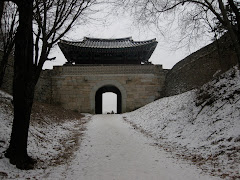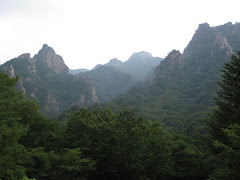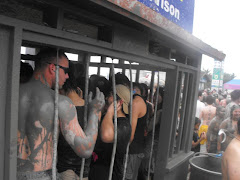Monday, November 30, 2009
Actually, I celebrated the Thanksgiving holiday rather well, considering my absence from North American soil. It all stared Thursday afternoon when I traveled to Seoul with my good friend, Gemma, for Thanksgiving lunch in The Oak Room of the famous Millennium Hilton. After spending several hours researching this, I learned there are a handful of restaurants in Seoul which offer a Thanksgiving "dinner", though most are a traditional dinner served 6-9pm, and thus, unavailable to someone like me who teaches at night. So, lunch was the next best option, which led us to the Oak Room at the Hilton; one of two restaurants offering a buffet lunch.
The buffet was a fantastic assortment of gourmet foods; an infusion of traditional Western items such as turkey with gravy, roast beef au jus, combined with some of the more traditional Asian classics such as kimchi and sashimi tuna, and paired with a spectacular bottle of Chilean carmenere, which, I must admit, balanced the flavors perfectly. Price aside, it was a great lunch, followed by a delightful two hour nap before that evening's classes. My only complaint, and a somewhat serious one; there was no stuffing or mashed potatoes to be found.
Friday night, I spent with a large group of foreigners in Sanbon, commiserating together and celebrating the American holiday over a long night filled with many, many drinks. We started at Outback Steakhouse for dinner (it was my first time eating at Korean Outback), and later progressed to some local watering holes. The group of roughly fifteen foreign teachers was actually composed of mostly Americans, along with one or two Canadians, and a European of Irish descent. While it was, in fact, a celebration, we were all missing our families and together enjoyed many lengthy discussions about the things we miss most.
Korean Thanksgiving, or Chuseok, is actually very similar to North American Thanksgiving, aside from the obvious differences, e.g., turkey, stuffing, mashed potatoes, and football. Because of the similarities, it's easy for many students and Korean friends to understand the emotions we foreigners feel during this time away from home. Chuseok is probably the most important Korean holiday, followed by the Lunar New Year, and Korean Independence Day. Similar to the American holiday, it's also the busiest travel day, and like most Korean holidays, it's a lunar holiday so the actual date changes each year. This year, Chuseok fell on a Saturday, October 3rd, and you may recall, I spent the four day weekend visiting friends in Pusan.
Moving on; a word about the notorious Swine Flu, or H1N1, as it is more commonly referred to:
So far, it has been reported that 82 people have died in South Korea from the virus, prompting the country to declare a red alert status. This has also caused a bit of a paranoia amongst the locals, as many are seen wearing surgical masks, and many public events have been cancelled in an effort to prevent transmission. While I funny support preventative measures against this pandemic, I do, however, have a few issues with some people's overreaction, and I sometimes take issue with the mask itself.
First of all, I have researched the effectiveness of the surgical mask and I have learned that, if worn properly, they can help reduce the spread of the virus, so I will acknowledge that. They do, however, also prevent a sense of false safety, and in my opinion, some people's actions can be hypocritical at times. As an example, one would think that more people would wash their hands after using the restroom, coughing, sneezing, etc. Instead, I continue to witness many people exit the restroom without washing, including those wearing masks. Example number 1.
Another example is the incessant spitting that is popular with most Korean men. Seriously, it's difficult to walk down the street, any street, without hearing someone clearing their throat and spitting on the walkway. No wonder people remove their shoes when entering homes. The spitting is so popular I have actually seen some people spit on the floors in public buildings, and drunken men clear their throats and hurl into an ashtray at a restaurant. It can be really, really disgusting at times. Example number 2.
What actually prompted me to comment on this subject was something I witnessed while visiting the temple in Haenam last weekend. There was a group of twenty-something girls touring the temple and many were wearing masks. Not an uncommon sight, but what was most intriguing about this was they each peeled back their masks to drink from the communal ladle which rests in the fountain. So my question following this observation, is the logic behind wearing a mask to prevent disease when you are not afraid to drink and press to your lips a ladle that is commonly shared by hundreds, if not thousands of others?? Example number 3.
I'm certain that many of these behaviors are not limited to South Korea and the Korean people, and so my comments are not meant to sound overly critical. Instead, I am only providing keen observations regarding public health and people's reaction to the pandemic.
Other noteworthy events:
Ski resorts in Gangwon Province have reported snow and are welcoming visitors. I am aware of five resorts located in Gyeonggi Province, or within a two hour trip from my home, and another six located in Gangwon Province. Plus, there are many resorts located throughout the Southern mountains. Many offer free shuttle service, all welcome snowboarders, and ticket prices seem reasonable. I can't wait to go.
Yuna Kim, the 19 year old international figure skating champion, continues to reign supreme following her seventh straight victory at last week's Grand Prix Skate America. Apparently, she broke her previous high score and world-record of 76.28 points. Because I know absolutely nothing about figure skating, nor do I pretend to, I will not mention anything further about this subject, other than she is a national hero and native of Sanbon. Her picture is everywhere, including a large banner on the side of Gunpo City Hall, and numerous endorsements throughout the country.
My good friends at the Korean Tourism Organization have announced 2009 was a record-setting year for tourists to visit South Korea. As of November 23rd, over 7 million visitors have landed on Korean shores, which is a 14 percent increase over the estimated 6 million visitors seen in 2008, and a two-fold increase over the 3.5 million visitors in 1994. What is most remarkable about this number, however, is that other Asian nations reported a 6 percent decrease in tourism numbers this year, with China and Japan leading these numbers at 14 and 25 percent respectively. The announcement comes at a time when worldwide tourism numbers are down almost 9 percent, mostly attributed to the worldwide recession and the increasing spread of H1N1.
The Korean Tourism Organization is currently in the midst of an aggressive marketing campaign, targeting overseas visitors and promoting the many wonderful attributes of South Korea, including the low value of the Won, which makes shopping advantageous for foreign visitors. I'd also like to think my blog had something to do with it, but I shall remain humble, and instead, encourage my friends and family to visit South Korea and eat some kimchi. Remember, mi couch su couch.
Lots of love in Korea and Happy Thanksgiving!
























































































































































